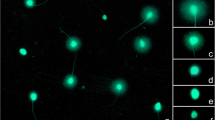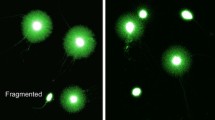Abstract
Among the currently available strategies for sperm freezing, vitrification may be considered as the leading alternative to conventional cryopreservation. Nevertheless, a direct comparison of both techniques with respect to the iatrogenic sperm DNA damage has not been performed yet. As such, this study was focused to assess the static and dynamic behavior of human sperm DNA damage following thawing of cryopreserved or vitrified spermatozoa. Semen samples were obtained from fifty donors with a normal spermiogram, and divided into four aliquots. The first aliquot represented the neat sample. In the second aliquot the seminal plasma was discarded, and the resulting sperm pellet was resuspended in PBS. The third fraction was used for slow freezing and the fourth fraction was subjected to vitrification. Each set of samples was incubated at 37 °C for 24 h and sperm DNA damage (SDF) was assessed using the chromatin-dispersion test following 0 h, 2 h, 4 h and 24 h of incubation. When comparing the rate of DNA fragmentation (r-SDF) at 2 h, significant differences were observed between the PBS group, cryopreserved (p .000) or vitrified semen (p .015). Furthermore, the sperm longevity comparison using Kaplan–Meier survival curves revealed significant differences between cryopreservation and vitrification (p .000). Our data suggest that exposure of spermatozoa to low temperatures, independently of the chosen freezing protocol, leads to a higher susceptibility of sperm DNA towards damage. This damage is nevertheless lower following vitrification in comparison to traditional cryopreservation. As vitrification leads to a smaller proportion of spermatozoa with DNA damage, we may recommend its use in reproductive techniques which rely on a longer sperm survival, such as artificial insemination.


Similar content being viewed by others
References
Agarwal A, Tvrda E, Sharma R (2014) Relationship amongst teratozoospermia, seminal oxidative stress and male infertility. Reprod Biol Endocrinol 12:45
Aizpurua J, Medrano L, Enciso M, Sarasa J, Romero A, Fernández MA, Gómez-Torres MJ (2017) New permeable cryoprotectant-free vitrification method for native human sperm. Hum Reprod 32:2007–2015
Ali Mohamed MS (2015) Slow cryopreservation is not superior to vitrification in human spermatozoa; an experimental controlled study. Iran J Reprod Med 13:633–644
Alvarez Sedó C, Bilinski M, Lorenzi D, Uriondo H, Noblía F, Longobucco V, Lagar EV, Nodar F (2017) Effect of sperm DNA fragmentation on embryo development: clinical and biological aspects. JBRA Assist Reprod 21:343–350
Björndahl L, Barratt CLR, Mortimer D, Jouannet P (2016) ‘How to count sperm properly’: checklist for acceptability of studies based on human semen analysis. Hum Reprod 31:227–232
Bogle OA, Kumar K, Attardo-Parrinello C, Lewis SE, Estanyol JM, Ballescà JL, Oliva R (2017) Identification of protein changes in human spermatozoa throughout the cryopreservation process. Andrology 5:10–22
Cooper TG, Noonan E, von Eckardstein S, Auger J, Baker HW, Behre HM, Haugen TB, Kruger T, Wang C, Mbizvo MT, Vogelsong KM (2010) World Health Organization reference values for human semen characteristics. Hum Reprod Update 16:231–245
Cuevas-Uribe R, Hu E, Daniels H, Gill AO, Tiersch TR (2017) Vitrification as an alternative approach for sperm cryopreservation in marine fishes. N Am J Aquac 79:187–196
Esteves SC, Agarwal A, Majzoub A (2017) The complex nature of the sperm DNA damage process. Transl Androl Urol 6:557–559
Gatimel N, Moreau J, Parinaud J, Léandri RD (2017) Sperm morphology: assessment, pathophysiology, clinical relevance, and state of the art in 2017. Andrology 5:845–862
Gosálvez J, López-Fernández C, Fernández JL, Esteves SC, Johnston SD (2015) Unpacking the mysteries of sperm DNA fragmentation: ten frequently asked questions. J Reprod Biotechnol Fertil 4:1–16
Gürler H, Malama E, Heppelmann M, Calisici O, Leiding C, Kastelic JP, Bollwein H (2016) Effects of cryopreservation on sperm viability, synthesis of reactive oxygen species, and DNA damage of bovine sperm. Theriogenology 86:562–571
Horta F, Alzobi H, Jitanantawittaya S, Catt S, Chen P, Pangestu M, Temple-Smith P (2017) Minimal volume vitrification of epididymal spermatozoa results in successful in vitro fertilization and embryo development in mice. Asian J Androl 19:107–112
Isachenko V, Maettner R, Petrunkina AM, Sterzik K, Mallmann P, Rahimi G, Sanchez R, Risopatron J, Damjanoski I, Isachenko E (2012) Vitrification of human ICSI/IVF spermatozoa without cryoprotectants: new capillary technology. J Androl 33:462–468
Lewis SE, John Aitken R, Conner SJ, Iuliis GD, Evenson DP, Henkel R, Giwercman A, Gharagozloo P (2013) The impact of sperm DNA damage in assisted conception and beyond: recent advances in diagnosis and treatment. Reprod Biomed Online 27:325–337
Merino O, Aguagüiña WE, Esponda P, Risopatrón J, Isachenko E, Isachenko V, Sánchez R (2015) Protective effect of butylated hydroxytoluene on sperm function in human spermatozoa cryopreserved by vitrification technique. Andrologia 47:186–193
O’Connell M, McClure N, Lewis SE (2002) The effects of cryopreservation on sperm morphology, motility and mitochondrial function. Hum Reprod 17:704–709
Oberoi B, Kumar S, Talwar P (2014) Study of human sperm motility post cryopreservation. Med J Armed Forces India 70:349–353
Ortiz I, Dorado J, Morrell J, Gosálvez J, Crespo F, Jiménez JM, Hidalgo M (2017) New approach to assess sperm DNA fragmentation dynamics: fine-tuning mathematical models. J Anim Sci Biotechnol 8:23
Riva NS, Marcial López CA, Martínez G, Iaizzo RS, Artola M, Ruhlmann C (2016) Análisis comparativo del congelamiento lento y la vitrificación para la criopreservación de espermatozoides. Reproducción 31:7–14
Sanchez R, Isachenko V, Petrunkina AM, Risopatron J, Schulz M, Isachenko E (2012) Live birth after intrauterine insemination with spermatozoa from an oligoasthenozoospermic patient vitrified without permeable cryoprotectants. J Androl 33:559–562
Tran M, Uriondo H, Nodar F, Alvarez Sedó C (2018) Cryopreservation promotes sperm DNA damage through oxidative stress. Obstet Gynecol 131:162S
Tvrdá E, López-Fernández C, Sánchez-Martín P, Gosálvez J (2018a) Sperm DNA fragmentation in donors and normozoospermic patients attending for a first spermiogram: Static and dynamic assessment. Andrologia 50(4):e12986
Tvrdá E, Arroyo F, Gosálvez J (2018b) Dynamic assessment of human sperm DNA damage I: the effect of seminal plasma-sperm co-incubation after ejaculation. Int Urol Nephrol 50:1381–1388
Uribe P, Rojas C, Meriño J, Zambrano F, Villegas JV, Treulen F, Boguen R, Isachenko V, Isachenko E, Sánchez R (2017) Effect of incubation temperature after devitrification on quality parameters in human sperm cells. Cryobiology 79:78–81
Wündrich K, Paasch U, Leicht M, Glander HJ (2006) Activation of caspases in human spermatozoa during cryopreservation—an immunoblot study. Cell Tissue Bank 7:81–90
Zheng WW, Song G, Wang QL, Liu SW, Zhu XL, Deng SM, Zhong A, Tan YM, Tan Y (2018) Sperm DNA damage has a negative effect on early embryonic development following in vitro fertilization. Asian J Androl 20:75–79
Acknowledgment
This work was supported by Programa Retos RTC-2016-4733-1 and the Slovak Research and Development Agency under the project no. APVV-15-0544.
Funding
This study was funded by the Programa Retos (RTC-2016–4733-1) and the Slovak Research and Development Agency (APVV-15–0544).
Author information
Authors and Affiliations
Corresponding author
Ethics declarations
Conflict of interest
All authors declare no conflict of interest.
Ethical approval
All procedures performed in studies involving human participants were in accordance with the ethical standards of the institutional and/or national research committee and with the 1964 Helsinki declaration and its later amendments or comparable ethical standards. This article does not contain any studies with animals performed by any of the authors.
Informed consent
Informed consent was obtained from all individual participants included in the study.
Additional information
Publisher's Note
Springer Nature remains neutral with regard to jurisdictional claims in published maps and institutional affiliations.
Rights and permissions
About this article
Cite this article
Tvrdá, E., Gosálvez, J., Arroyo, F. et al. Dynamic assessment of human sperm DNA damage III: the effect of sperm freezing techniques. Cell Tissue Bank 22, 379–387 (2021). https://doi.org/10.1007/s10561-020-09883-8
Received:
Accepted:
Published:
Issue Date:
DOI: https://doi.org/10.1007/s10561-020-09883-8




